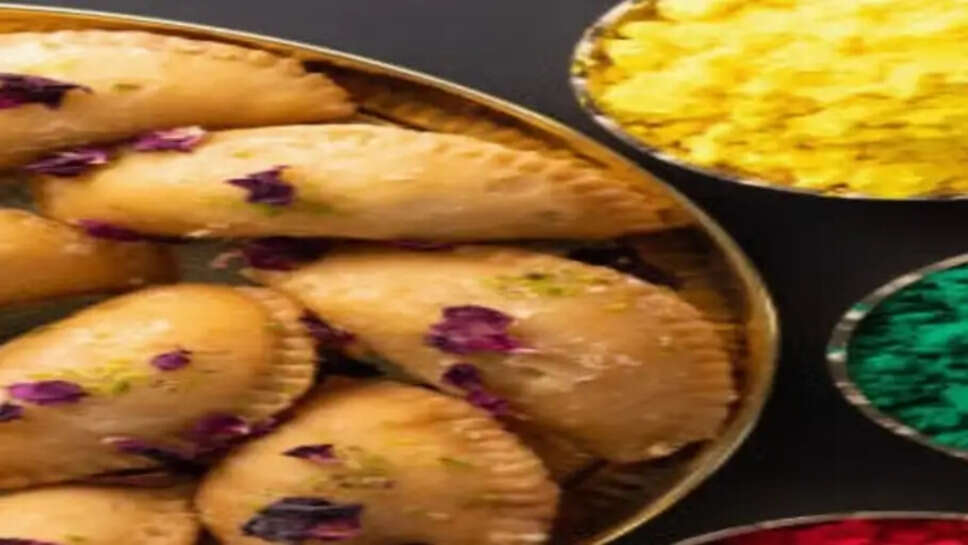From UP's Gujiya to Maharashtra's Karanji: Different ways the HOLI sweet is made across India
Holi is not just about playing with colours; it’s also about indulging in delicious sweets that make the celebration even sweeter. One of the most beloved treats enjoyed during this time is the gujiya. But did you know that this crispy, stuffed delight has many names and variations across India? Let’s take a sweet tour across the country to explore the different ways this traditional treat is made and enjoyed.
Mar 10, 2025, 04:57 IST

Karanji: The name for gujiya in Maharashtra
In Maharashtra, the gujiya goes by the name karanji. These sweet pockets are stuffed with a mixture of coconut, nuts, and jaggery, giving them a unique flavor that reflects the region’s love for coconut-based sweets. Though it shares the same shape as the gujiya, its stuffing is often a little different, leaning heavily into the regional ingredients that are abundant in the area. Crisp, golden, and irresistibly sweet, karanjis are a must-have during Holi in this vibrant state.
Holi, the vibrant festival of colors, is celebrated with an array of traditional sweets across India. Among these, Gujiya and Karanji are quintessential delicacies that, while similar in appearance, showcase regional flavors and preparations unique to Uttar Pradesh and Maharashtra, respectively.
Gujiya from Uttar Pradesh
Gujiya is a classic North Indian sweet, especially popular in Uttar Pradesh during Holi. These half-moon shaped pastries are made from a crisp, flaky dough filled with a rich mixture of khoya (milk solids), sugar, and nuts. The outer shell is crafted from all-purpose flour (maida) mixed with ghee, resulting in a tender yet crunchy texture upon frying.
Preparation Highlights:
Dough: A mixture of maida and ghee is combined to form a crumbly texture, then kneaded into a firm dough with water.
Filling: Khoya is roasted until it attains a light brown hue, then mixed with powdered sugar, chopped nuts, and sometimes desiccated coconut for added flavor.
Assembly: Small discs of dough are filled with the khoya mixture, folded into a semi-circle, and sealed meticulously to prevent the filling from leaking during frying.
Cooking: The filled gujiyas are deep-fried until golden brown, achieving a crisp exterior that complements the sweet, rich filling.
For a visual guide to making Mawa Gujiya, you can refer to this video:
Karanji from Maharashtra
Karanji, known as Kajjikayalu in some southern states, is a Maharashtrian delicacy traditionally prepared during festivals like Diwali and Holi. Similar in shape to Gujiya, Karanji features a distinct filling primarily composed of coconut, which imparts a unique flavor and texture.
Preparation Highlights:
Dough: A blend of maida, semolina (rava), and ghee is combined to form a smooth, pliable dough. The addition of semolina contributes to the crispiness of the outer shell.
Filling: Fresh or desiccated coconut is roasted and mixed with sugar (or jaggery), cardamom powder, and occasionally poppy seeds and chopped nuts. This aromatic mixture serves as the core of Karanji.
Assembly: Dough discs are filled with the coconut mixture, folded, and sealed, often with decorative crimps along the edges.
Cooking: The prepared karanjis are deep-fried until they attain a light golden color, resulting in a flaky and flavorful pastry.
For a detailed recipe on Maharashtrian Karanji, you can visit:
Regional Variations and Similarities
While both Gujiya and Karanji share a common concept of sweet-filled pastries, their regional adaptations highlight the diversity of Indian cuisine:
Filling Ingredients: Gujiya predominantly uses khoya and nuts, offering a rich, creamy texture, whereas Karanji emphasizes coconut, providing a sweet, chewy bite with a hint of nuttiness.
Dough Composition: The inclusion of semolina in Karanji's dough contributes to its distinctive crispiness, setting it apart from the solely maida-based Gujiya.
Festive Occasions: Both sweets are integral to festive celebrations, with Gujiya being synonymous with Holi in North India and Karanji featuring prominently during Diwali and Holi in Maharashtra.
These delightful sweets not only satisfy the palate but also embody the rich cultural tapestry of India's culinary traditions, making festivals like Holi a truly flavorful experience.
